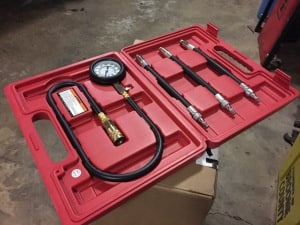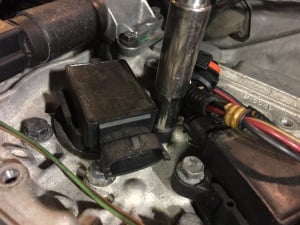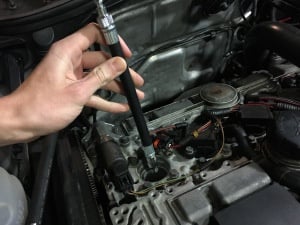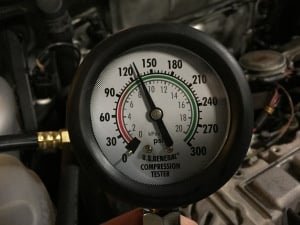- 02/13/2015
- 2 Min Read
- By: Alex Fiehl
How to do a Compression Test on a 5-Cylinder Volvo
Burning oil, low power, or misfires getting you down? Compression is the driving force that keeps an engine alive, and not enough can mean any one of these factors will set in. Often considered the benchmark of an engine's health, a compression test can provide a wealth of information to an avid DIY-er, as well as rule out a plethora of issues that can plague an engine.
What is compression?
Picture this moment in time: The compression stroke of a 4-stroke engine occurs right before ignition. The fuel and air have already been sucked into the cylinder, and the piston is coming up one last time before the spark plugs fire and blow it all up. The valves are all closed in the cylinder head, so the cylinder is completely sealed. When the piston starts moving up, the air/fuel mixture is being crammed into a space that is getting smaller and smaller. This amount of pressure is measured in PSI, or pounds per square inch. A strong compression number indicates that the valves, head gasket, and piston rings are all sealing as designed with minimal blow-by. On the other hand, a low compression number can mean that any of these things are leaking.
Test compression with a lukewarm engine and the throttle wide-open.
Dry Test
Step 1: Grab a compression tester. These often have a gauge and various fittings for various spark plug sizes.

Step 2: Remove the spark plug cover. 93-09 "Whiteblock" 5-cylinder engines are all very similar, they use T30 Torx screws to hold the spark plug cover on.
Step 3: Disconnect and remove the coil packs (or spark plug wires) using a 10mm socket.
Step 4: Remove all 5 spark plugs and set aside.
Step 5: Remove the fusebox cover using a T25 Torx driver and pull the red fuel pump relay. This is important - you do not want fuel spraying into the cylinders needlessly during the test.
Step 6: Thread the compression tester fitting in by hand and tighten until the o-ring is sealed into the cylinder head. This does not need to be extremely tight.
Step 7: Connect the gauge, make sure the throttle is wide-open, and turn the engine over without stopping for 7-10 cranks. (Listen - the engine usually spins in a rhythmic fashion)
Step 8: Read the gauge, it is equipped with a check valve and won't lose pressure while you're in the car cranking.
This test resulted in approximately 135psi on one cylinder. (I didn't have the throttle opened, and did not perform a wet test afterwards) For my turbo engine this is a bit low, but I am using a gauge of questionable quality as well. If the other four cylinders measure the same, it's generally okay. Drastic changes between cylinders indicate problems.
Wet Test
A wet compression test only needs to be performed on an engine with low compression. Doing this focuses the test's results on the piston rings. By pouring a small amount of oil in each spark plug hole, the piston rings will achieve a better seal with the cylinder walls. If a wet test results in higher compression numbers than the dry test produced, the failure point has been narrowed down to the piston rings. In theory, you do not want a wet test to result in drastically higher compression numbers. Think single digits, max.
Ideal compression numbers:
1993-1997 850 Non-Turbo: 185-213psi
1993-1997 850 Turbo: 156-185psi
These ranges are generally applicable to all turbo and non-turbo 5-cylinder Volvos. The concept still applies - a non-turbo engine will have a higher compression ratio, while a turbo engine has less.














